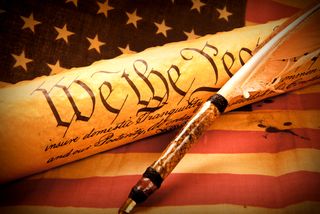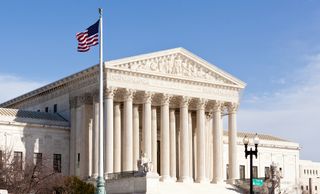
When you purchase through links on our site, we may earn an affiliate commission. Here’s how it works.
The Second Amendment provides U.S. citizens the right to bear arms. Ratified in December 1791, the amendment says:
A well regulated Militia, being necessary to the security of a free State, the right of the people to keep and bear Arms, shall not be infringed.
James Madison originally proposed the Second Amendment shortly after the Constitution was officially ratified as a way to provide more power to state militias, which today are considered the National Guard. It was deemed a compromise between Federalists — those who supported the Constitution as it was ratified — and the anti-Federalists — those who supported states having more power. Having just used guns and other arms to ward off the English, the amendment was originally created to give citizens the opportunity to fight back against a tyrannical federal government.

Since its ratification, Americans have been arguing over the amendment's meaning and interpretation. One side interprets the amendment to mean it provides for collective rights, while the opposing view is that it provides individual rights.
Those who take the collective side think the amendment gives each state the right to maintain and train formal militia units that can provide protection against an oppressive federal government. They argue the "well regulated militia" clause clearly means the right to bear arms should only be given to these organized groups. They believe this allows for only those in the official militia to carry guns legally, and say the federal government cannot abolish state militias.
Those with the opposite viewpoint believe the amendment gives every citizen the right to own guns, free of federal regulations, to protect themselves in the face of danger. The individualists believe the amendment's militia clause was never meant to restrict each citizen's rights to bear arms.
Both interpretations have helped shape the country's ongoing gun control debate. Those supporting an individual's right to own a gun, such as the National Rifle Association, argue that the Second Amendment should give all citizens, not just members of a militia, the right to own a gun. Those supporting stricter gun control, like the Brady Campaign, believe the Second Amendment isn't a blank check for anyone to own a gun. They feel that restrictions on firearms, such as who can have them, under what conditions, where they can be taken, and what types of firearms are available, are necessary.
While the right to bear arms is regularly debated in the court of public opinion, it is the Supreme Court whose opinion matters most. Yet despite an ongoing public battle over gun ownership rights, until recent years the Supreme Court had said very little on the issue.

One of the first rulings came in 1876 in U.S. v. Cruikshank. The case involved members of the Ku Klux Klan not allowing black citizens the right to standard freedoms, such as the right to assembly and the right to bear arms. As part of the ruling, the court said the right of each individual to bear arms was not granted under the Constitution. Ten years later, the court affirmed the ruling in Presser v. Illinois when it said that the Second Amendment only limited the federal government from prohibiting gun ownership, not the states.
The Supreme Court took up the issue again in 1894 in Miller v. Texas. In this case, Dallas' Franklin Miller sued the state of Texas, arguing that despite state laws saying otherwise, he should have been able to carry a concealed weapon under Second Amendment protection. The court disagreed, saying the Second Amendment does not apply to state laws, like Texas' restrictions on carrying dangerous weapons.
All three of the cases heard before 1900 cemented the court's opinion that the Bill of Rights, and specifically the Second Amendment, does not prohibit states from setting their own rules on gun ownership.
Until recently, the Supreme Court hadn't ruled on the Second Amendment since U.S. v. Miller in 1939. In that case, Jack Miller and Frank Layton were arrested for carrying an unregistered sawed-off shotgun across state lines, which had been prohibited since the National Firearms Act was enacted five years earlier. Miller argued that the National Firearms Act violated their rights under the Second Amendment. The Supreme Court disagreed, however, saying "in the absence of any evidence tending to show that possession or use of a 'shotgun having a barrel of less than eighteen inches in length' at this time has some reasonable relationship to the preservation or efficiency of a well regulated militia, we cannot say that the Second Amendment guarantees the right to keep and bear such an instrument."
It would be nearly 70 years before the court took up the issue again, this time in the District of Columbia v. Heller in 2008. The case centered on Dick Heller, a licensed special police office in Washington, D.C., who challenged the nation's capital's handgun ban. For the first time, the Supreme Court ruled that despite state laws, individuals who were not part of a state militia did have the right to bear arms. As part of its ruling, the court wrote, "The Second Amendment protects an individual right to possess a firearm unconnected with service in a militia, and to use that arm for traditionally lawful purposes, such as self-defense within the home."
The court would rule on the issue again two years later as part of McDonald v. City of Chicago, which challenged the city's ban on private handgun ownership. In a similar 5-to-4 ruling, the court affirmed its decision in the Heller case, saying the Second Amendment "applies equally to the federal government and the states."
In 2016, the Supreme Court again ruled on a right-to-bear-arms case, Caetano v. Massachusetts. The case involved a woman who was in possession of a stun gun for self-defense against an abusive ex-boyfriend. Because stun guns were illegal under Massachusetts law, the woman was arrested and convicted for possessing the weapon. The case made its way to the Supreme Court, which ruled that stun guns and, indeed "all instruments that constitute bearable arms," are protected under the Second Amendment.
In 2017, the Supreme Court declined to hear Peruta v. California, a gun-rights case centering around concealed carry, or the right to carry a concealed handgun in public. California requires that applicants for a concealed carry license show "good cause," such as a specific threat to a person's safety. A Vietnam veteran named Edward Peruta challenged this requirement as a curtailment of his Second Amendment rights. While Heller was a case about keeping firearms in the home for self-protection, Peruta v. California was about whether that right extends to the public sphere. Justice Clarence Thomas and new justice Neil Gorsuch dissented from the refusal to review the case, indicating that the Supreme Court's newest justice may be particularly conservative on gun rights.
Meanwhile, the battle over gun rights continues at the state level. A 2016 working paper from Harvard Business School researchers found that a mass shooting leads to a 15 percent increase in the number of firearm-related bills introduced into the state legislature that year. The more fatalities, the larger the increase in firearm bills. But the bills aren't always what you might expect: When Republicans hold power in the state legislature after a mass shooting, the number of laws enacted to loosen gun restrictions goes up 75 percent. Democrat-controlled legislatures, on the other hand, did not enact a higher rate of regulation-tightening laws immediately after mass shootings than before.
"This is consistent with survey evidence suggesting that even when a majority supports a gun-control proposal, those opposed to increased gun control are more likely to take actions like writing a letter or donating money to support their side," the researchers wrote.
Despite the recent rulings, the debate on gun control continues. Incidents like those in Aurora, CO and Sandy Hook in Newtown, CT only serve as motivation for both sides to have their opinions heard and considered.
Related:
Editor's Note: This reference article was first published on Jan. 22, 2013. It was updated with new cases and information on June 26, 2017.
Get the world’s most fascinating discoveries delivered straight to your inbox.